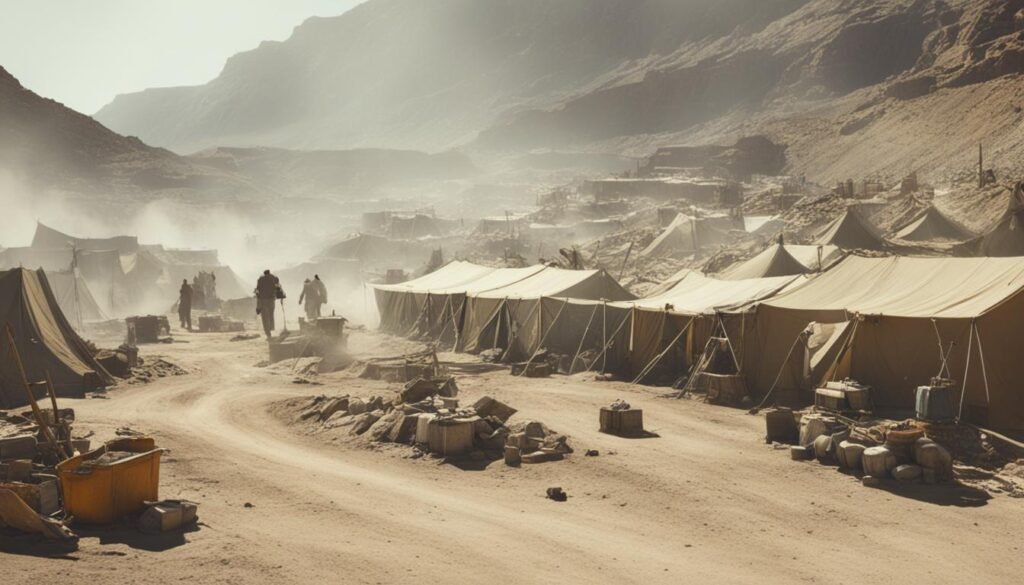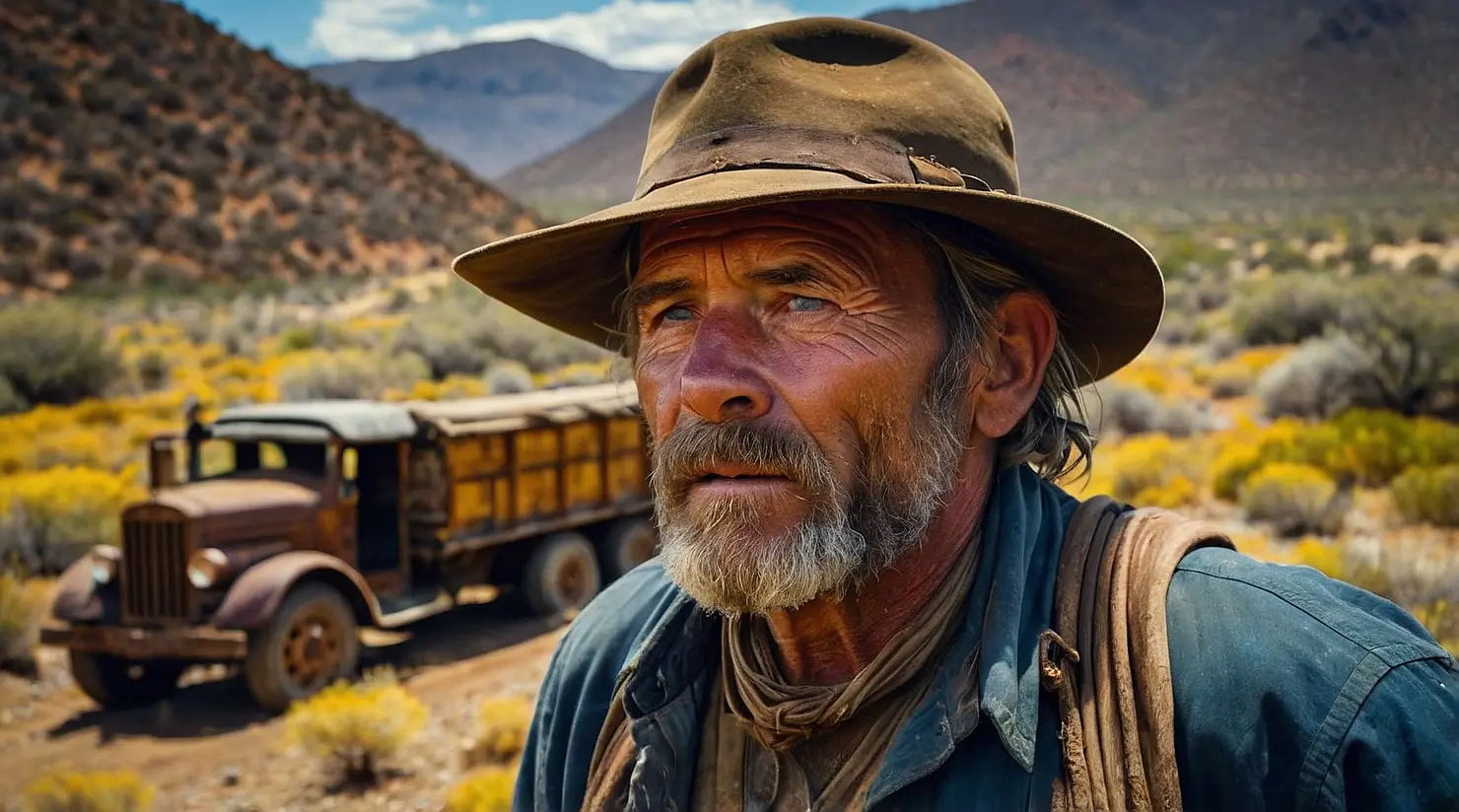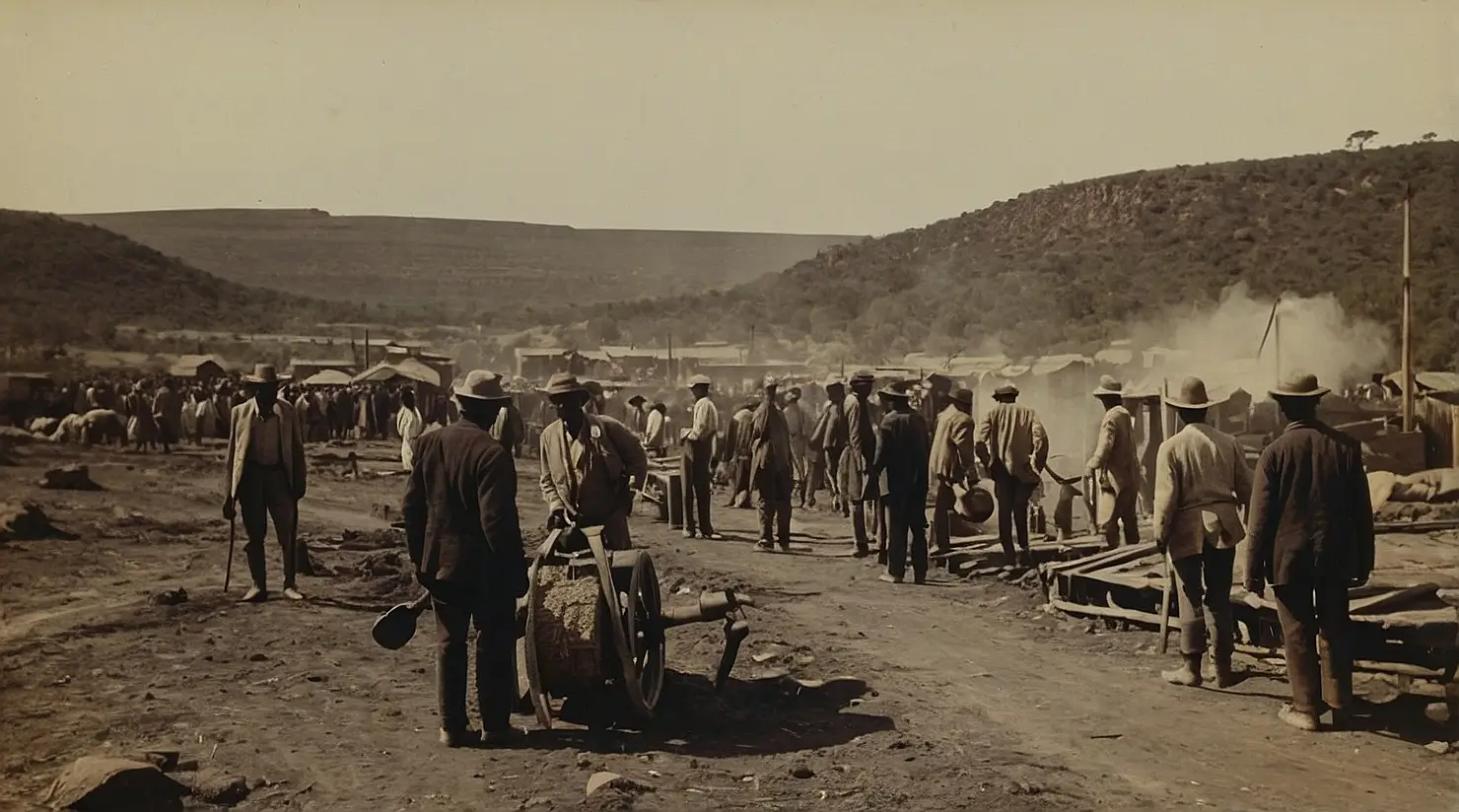In the late 19th century, South Africa went through a big change.
This change started a rush for minerals and began the South African Gold Rush era.
This event changed the country’s economy and had a big impact on its society and politics.
Let’s explore this exciting time and find out what made the Witwatersrand Basin so special.
Key Takeaways about South African Gold Rush
- The South African Gold Rush of the late 19th century transformed the country, fueling a surge in mining activity and the development of Johannesburg.
- The discovery of gold deposits in the Witwatersrand Basin, an area the size of West Virginia, sparked a global frenzy, with nearly half the gold ever mined in human history coming from this region.
- The Witwatersrand Basin’s conglomerates, originally carried in by a system of braided rivers, contained an extraordinary concentration of gold, making it one of the world’s most significant gold repositories.
- The rise of mining empires and the emergence of influential figures, known as the Randlords, played a pivotal role in shaping the gold rush and South Africa’s economic and social landscape.
- The legacy of the South African Gold Rush continues to reverberate through the country’s economy, with gold trading remaining a crucial component and a hedge against economic uncertainties.
South African Gold Rush: Unveiling the Golden Era
The Glittering Discovery: Witwatersrand Basin
The Witwatersrand Basin in South Africa is a treasure trove of gold. It’s where a huge amount of gold has been found. This area is responsible for nearly half of all gold mined worldwide. The gold comes from conglomerates, which are rocks made of quartz pebbles stuck together.
Unveiling the World’s Largest Gold Repository
The Witwatersrand Basin is huge, stretching 300 km long and 150 km wide. It’s one of the biggest places on Earth for finding gold. The rocks here, from the Witwatersrand Supergroup, were formed over 260 million years ago.
Buy Gold Online: The Smart and Secure Way
Discover the safest and most reliable strategies to buy gold online. Make informed investment decisions and secure your financial future today!
Learn MoreSome of these gold-rich areas are buried deep, up to 4 km below the surface.
The Significance of the Witwatersrand Conglomerates
The Witwatersrand conglomerates hold the key to the basin’s vast mineral wealth. These rocks, made of quartz pebbles, have sparked a lot of debate among scientists. They wonder how the gold got there, with two main theories: the “placer” and “hydrothermal” models.
| Gold Rush | Location | Time Period | Impact |
|---|---|---|---|
| California Gold Rush | California, USA | 1848-1855 | Attracted over 300,000 people and boosted California’s economy |
| Klondike Gold Rush | Yukon, Canada | 1896-1899 | Tens of thousands of prospectors flocked to the region, leading to the development of Dawson City |
| Witwatersrand Gold Rush | South Africa | 1886-present | Transformed South Africa’s economy and society, with gold production increasing from 27.2 tons in 1898 to 146.0 tons in 1913 |
“The Witwatersrand Basin is one of the world’s largest gold deposits, accounting for nearly half of all the gold ever mined in human history.”
Tracing the Origins: Placer vs. Hydrothermal Models
The origins of the gold in South Africa’s Witwatersrand Basin have sparked a long debate. Two main theories have come forward: the placer model and the hydrothermal model.
The placer model says gold came from ancient rivers and streams. These carried gold grains and deposited them with other sediments. This is backed by the gold’s age, around 3.016 billion years old, which is before the basin was formed.
On the other hand, the hydrothermal model suggests gold came from deep in the Earth. These gold-rich fluids added to the sedimentary basin later. This idea is supported by changes seen in the Witwatersrand rocks, showing fluid movement.
Figuring out which theory is right is key to understanding the area’s geological past. It also helps guide future searches for gold. The Witwatersrand Basin has given about 30% of the world’s gold in the last 6,000 years. This makes it a top gold spot globally.
| Placer Model | Hydrothermal Model |
|---|---|
| Gold grains transported and deposited by ancient rivers and streams | Gold-rich fluids from deep within the Earth’s crust added to the sedimentary basin |
| Witwatersrand gold dated to around 3.016 billion years old, predating the basin formation | Extensive alteration patterns in the Witwatersrand rocks indicate significant fluid flow |
| Supports the formation of gold-bearing conglomerates through natural sorting processes | Emphasizes the study of alteration through whole rock geochemistry and connection between fluid flow, rock alteration, and gold precipitation |
The debate on the Witwatersrand goldfields’ origins is ongoing. Both the modified placer model and the hydrothermal model provide valuable insights. Knowing the truth about these deposits will guide future mining and exploration in the area.
“The origin of the Witwatersrand goldfields is the most disputed issue in economic geology.”
– Charles Davidson, renowned geologist
The South African Gold Rush

The South African gold rush started in the 1850s and changed the region forever. It began with a big find in 1885 by George Walker and George Harrison. They found gold-rich rocks on an old farm near Johannesburg.
George Walker and George Harrison’s Serendipitous Find
This find brought many people to the area, seeking fortune. News of the gold in the Witwatersrand Basin spread fast. Prospectors from around the world came, hoping to strike it rich.
The Birth of Johannesburg: From Farmland to Boomtown
The area quickly grew from farmland to the busy city of Johannesburg. It became the heart of South Africa’s gold mining. In ten years, Johannesburg’s population jumped from a few thousand to over 100,000, beating Cape Town.
The South African gold rush caused a big change in the economy and population. The discovery of gold in the Witwatersrand Basin near Johannesburg attracted many prospectors and miners. This led to the fast growth of Johannesburg, making it the biggest city in South Africa.
“The Witwatersrand Gold Rush was a key factor in the failed Jameson Raid of 1895-1896 and the outbreak of the Second Boer War in 1899.”
The South African gold rush had a lasting impact on the country. It shaped Johannesburg and the mining industry, which became key to South Africa’s economy. The discovery of gold and the growth of the mining industry changed the country in many ways, effects still seen today.
Mining Magnates and the Randlords
The South African Gold Rush drew many mining magnates and entrepreneurs. They wanted to make money from the area’s huge mineral wealth. These leaders, called “Randlords,” built big gold mining empires. They had a lot of economic power and influence.
Cecil Rhodes was a top Randlord. He changed the mining industry and South Africa’s future. Rhodes made a huge fortune from diamonds and gold. He used his money and connections to grow British rule in the area.
| Key Statistic | Value |
|---|---|
| European investment in South Africa at the end of the nineteenth century | Equivalent to all European investment in the rest of Africa |
| The Natives Land Act of 1913 | Reserved most of the land in South Africa for white ownership, restricting black land ownership to 13% of the country |
| South Africa’s share of global gold reserves | Over 50% of all gold reserves globally are found in South Africa, with the Witwatersrand holding the world’s largest gold reef |
| South Africa’s gold production in the 1980s | Accounted for 50% of global gold production |
The mining magnates and Randlords changed South Africa’s economy and politics. Their huge mineral wealth and power let them influence the mining world and politics.
The Rise of Gold Mining Empires
The discovery of lots of gold reserves in the Witwatersrand Basin brought in lots of money and started many gold mining empires in South Africa. These mining magnates and Randlords made a lot of money. Their reach went beyond mining, affecting South Africa’s society, economy, and politics.
The gold mining empires had a big effect on South Africa. The money from mineral extraction helped the country grow economically and industrially. But, it also caused big social and racial divides. This led to the Natives Land Act of 1913, a law that separated people by race.
Life in the Mining Camps

The late 19th century South African Gold Rush drew many to the Witwatersrand Basin. Prospectors, miners, and their families settled in mining camps. These places had tough living, no basic infrastructure, and daily struggles.
The Harsh Realities of the Gold Rush Era
By 1899, over 100,000 people worked in South Africa’s gold mines. Most were Black migrant workers. They worked hard and earned much less than white workers. Their homes were small and dirty, with little clean water or medical care.
Prospectors faced many challenges, like hard work and dangers. In the California gold rush, miners worked long hours, starting early every day. They went to the mines six days a week.
The mining camps were tough for everyone. In the Anglo-Boer War, many Afrikaner women and children died in camps. Also, 14,000 Black people died in their own camps.
| Year | Percentage of World’s Gold Produced in the Transvaal | Quantity of Gold Produced in the Transvaal (in pounds) |
|---|---|---|
| 1895 | 21.0% | £40,843,000 |
| 1900 | 2.8% | £52,312,000 |
| 1905 | 26.8% | £77,756,000 |
| 1910 | 34.3% | £93,332,000 |
| 1915 | 39.7% | £97,218,000 |
| 1920 | 49.7% | £69,739,000 |
| 1925 | 50.4% | £80,817,000 |
| 1935 | 34.8% | £131,680,000 |
| 1940 | 34.4% | £173,354,000 |
The table shows how important the Transvaal was in gold production. By the 1920s, it produced over 50% of the world’s gold.
Despite the challenges, the Gold Rush changed the region. It brought people from all over and helped the economy grow. The stories of those in the mining camps tell us about this important time in South Africa’s history.
South African Gold Rush: Unveiling the Golden Era
The late 19th century South African Gold Rush was a key moment in history. It brought a “golden era” that changed the country’s economy, society, and culture. The find of huge gold deposits in the Witwatersrand Basin led to a mining boom. This boom made Johannesburg grow fast, changing South Africa’s future.
This period was a time of big changes in the economy and society. Many people from all over the world came for the gold. They turned Johannesburg from a small farm town into a big city. It became the heart of South Africa’s mining.
Today, the gold rush’s impact is still seen in South Africa’s economy and growth. The gold brought a lot of wealth and helped build new roads, cities, and networks. These changes still shape the country.
The gold rush also changed culture, bringing new people and ideas together. It created a mix of communities that have shaped South Africa’s culture. The mining industry and its traditions are a big part of South Africa’s story.
The South African Gold Rush was a big turning point. It started a new era of growth in the economy, society, and culture. Its effects are still seen today, showing how important natural resources can be and how a country can adapt to big changes.
“The South African Gold Rush was a pivotal moment in the country’s history, ushering in a transformative ‘golden era’ that left an indelible mark on the nation’s economy, society, and culture.”
| Key Statistics | Value |
|---|---|
| Estimated rhinos in Sabi Sands Game Reserve | 5,000 |
| Gold rush in Pilgrim’s Rest attracted around | 1,500 people |
| Gold discovery by Alec ‘Wheelbarrow’ Patterson in 1873 | Thousands of gold-diggers joined the rush |
| Pilgrim’s Rest became a town | 1876 |
| Selati Line passenger service ceased | 1973 |
The South African Gold Rush had a huge effect on the country’s growth and identity. The find of gold in the Witwatersrand Basin brought many people and made Johannesburg grow fast. This era left a lasting mark on South Africa’s economy, society, and culture. The mining industry and its traditions are still a big part of who they are today.
The Legacy of the Witwatersrand Basin
The Witwatersrand Basin is famous for its huge gold deposits. These have greatly affected South Africa’s economy and growth. Almost half of all gold mined worldwide comes from here. This has made the mining industry huge and turned South Africa into a key player in the global economy.
This region is more than just rich in minerals. It has also deeply influenced South Africa’s society, politics, and culture. The impact is huge and far-reaching.
Lasting Impact on South Africa’s Economy and Development
In 1886, finding gold in the Witwatersrand Basin started a big gold rush. This led to the creation of Johannesburg and fast growth in the area. Soon, settlements turned into cities with schools, hospitals, and businesses.
For over a century, the Witwatersrand Basin has been a top source of gold, making South Africa a major producer. This wealth helped the country grow industrially and build its infrastructure. It led to the making of railways, roads, and better communication systems.
But, mining here has also had big environmental and social effects. Mine waste has made rivers salty, and the gold extraction process has harmed the environment and people’s health. As easy gold spots ran out, mining got harder. This caused problems like labor disputes, health issues for miners, and more people living in informal settlements near mines.
Even with these problems, the Witwatersrand Basin’s legacy is huge. It has changed South Africa’s economy, society, politics, and culture. The basin has left a lasting mark on the country and the world.
Preserving the Golden Heritage
The Gold Reef City theme park was made to keep alive the history of the South African Gold Rush. It’s built on the old Crown Mines site in Johannesburg. Gold Reef City takes you back to the mining town days, with its sights, sounds, and feelings.
It shows off real-life scenes, educational displays, and fun attractions. Gold Reef City makes sure we don’t forget the impact of the gold rush on South Africa. You can see the mine shafts, check out old machines, and even try panning for gold.
Gold Reef City: A Living Museum of the Gold Rush Era
Gold Reef City is on the site of the Crown Mines, where 80 tons of gold were found. It lets you step back in time. The park has streets, buildings, and mines that show off Johannesburg history and heritage preservation of the Gold Rush era.
Here, you can feel what life was like for miners and prospectors in the Witwatersrand Basin. You’ll hear machines clang and see the trading posts come alive. Gold Reef City makes the Gold Rush come alive.
With interactive exhibits, educational displays, and exciting rides, Gold Reef City keeps the heritage of this important time in South African history alive. It’s a place that draws in visitors from all over the world.
“Gold Reef City takes you back in time, letting you feel the energy and excitement of the South African Gold Rush. It’s a top spot for anyone wanting to dive into the country’s history and culture.”
For an overview about the Gold Rush Area, please check this guide.
Conclusion
The South African Gold Rush in the late 19th century was a key event in the country’s history. It led to fast growth and change that still affects South Africa today. The discovery of gold in the Witwatersrand Basin sparked the rise of mining and made Johannesburg a major city.
Gold Reef City is a place that honors this era. It shows how the gold rush changed South Africa’s economy, society, and culture. Even now, the gold rush’s impact is still felt, especially with the problems of old mines.
Yet, the South African Gold Rush shows how human creativity and the drive for success can change things. It’s a story that still moves and motivates people. It tells us how one big find can change a country’s future.
FAQ about South African Gold Rush
What was the significance of the Witwatersrand Basin in the South African Gold Rush?
The Witwatersrand Basin in South Africa holds nearly half of the world’s gold ever mined. This vast gold was found in the basin’s rocks. It was the main reason for the South African Gold Rush.
What are the two major theories for the origin of gold in the Witwatersrand Basin?
There are two main theories. The “placer” model says gold came from rivers depositing it with other sediments. The “hydrothermal” model believes gold came from deep Earth fluids, adding it to the basin later.
How did the South African Gold Rush transform the region?
Finding gold in 1885 near Johannesburg brought many miners and fortune-seekers. This turned the area into the busy city of Johannesburg. It became the heart of South Africa’s gold mining.
Who were the Randlords and what was their role in the South African Gold Rush?
Randlords were big mining bosses who wanted to make the most of the Witwatersrand Basin’s gold. People like Cecil Rhodes built huge gold mines. They had a lot of power in both business and politics during the Gold Rush.
What were the realities of life in the mining camps during the South African Gold Rush?
Mining camps were tough places with poor living conditions and no basic amenities. Miners faced hard work, diseases, and accidents. These challenges shaped the lives of those in the mining camps.
How has the legacy of the South African Gold Rush been preserved?
The Gold Reef City theme park in Johannesburg keeps the Gold Rush history alive. It’s like stepping back into a mining town during the gold rush. Visitors can see and feel what life was like back then.

Source Links
- https://www.americanscientist.org/article/the-origin-of-gold-in-south-africa
- https://www.newyorker.com/magazine/2023/02/27/the-dystopian-underworld-of-south-africas-illegal-gold-mines
- https://www.cbn.co.za/industry-news/business-advisory-financial-services/the-golden-journey-unveiling-south-africas-wealthy-legacy-and-prospects-in-gold-investment/
- https://medium.com/@AIGOLDOfficial/the-glittering-legacy-famous-gold-discoveries-and-their-impact-on-societies-d884e0a67eb9
- https://en.wikipedia.org/wiki/Witwatersrand
- https://boonit.co.uk/blog/the-most-famous-gold-discoveries-in-history/
- http://www.geotimes.org/apr06/feature_GoldOrigins.html
- https://www.sciencedirect.com/science/article/abs/pii/S0169136814002467
- https://open.uct.ac.za/bitstreams/00d625c3-11a7-4c4c-85b2-faed7b70e8bb/download
- https://www.britannica.com/place/Johannesburg-South-Africa/History
- https://en.wikipedia.org/wiki/Witwatersrand_Gold_Rush
- https://www.thenaturalsapphirecompany.com/education/additional-precious-metals-information/witwatersrand-gold-rush/
- https://www.sahistory.org.za/article/grade-8-term-2-mineral-revolution-south-africa
- https://www.corruptionwatch.org.za/south-africas-history-of-gold-mining-corruption-abuse-and-secrecy/
- https://en.wikipedia.org/wiki/Mining_industry_of_South_Africa
- https://www.britannica.com/place/South-Africa/Gold-mining
- https://www.joliet86.org/assets/1/6/Life_as_a_Miner.pdf
- https://www.sahistory.org.za/archive/all-glitters-glitter-gold-emilia-potenza
- https://www.lonelyplanet.com/articles/south-africa-gold-rush
- https://phys.org/news/2017-04-formation-gold-deposits-south-africa.html
- https://www.nma.org/pdf/gold/gold_history.pdf
- https://www.sciencedirect.com/science/article/abs/pii/S1464343X12000593
- https://www.linkedin.com/pulse/golden-legacy-gold-mining-south-africa-rorisang-masibi
- https://placesjournal.org/article/ecologies-of-gold-mining-landscapes-of-johannesburg/
- https://www.mgsrefining.com/blog/krugerrand-phenomenon/


